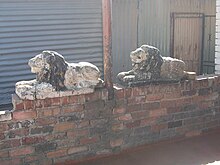
Soweto is a township of the City of Johannesburg Metropolitan Municipality in Gauteng, South Africa, bordering the city's mining belt in the south. Its name is an English syllabic abbreviation for South Western Townships. Formerly a separate municipality, it is now incorporated in the City of Johannesburg Metropolitan Municipality, and one of the suburbs of Johannesburg.
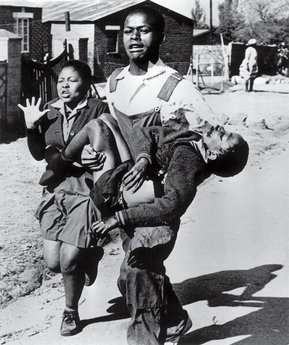
Zolile Hector Pieterson was a South African schoolboy who was shot and killed at the age of 12 during the Soweto uprising, when the police opened fire on black students protesting the enforcement of teaching in Afrikaans, mostly spoken by the white and coloured population in South Africa, as the medium of instruction for all school subject whereas they wanted to learn in their native languages, Xhosa and Zulu. A news photograph by Sam Nzima of the mortally wounded Pieterson being carried by another Soweto resident while his sister ran next to them was published around the world. The anniversary of his death is designated Youth Day in South Africa.

The suburbs of Johannesburg are officially demarcated areas within the City of Johannesburg Metropolitan Municipality, South Africa. As in other Commonwealth countries, the term suburb refers to a "neighbourhood", although in South Africa most "suburbs" have legally recognised borders and often separate postal codes. The municipal functions for the area, such as municipal policing and social services, are still managed by the city government.
Orlando is a township in the urban area of Soweto, South Africa. The township was founded in 1931 and named after Edwin Orlando Leake, Mayor of Johannesburg from 1925 to 1926. It is divided in two main areas: Orlando West and Orlando East.

Kliptown is a suburb of the formerly black township of Soweto in Gauteng, South Africa, located about 17 km south-west of Johannesburg. Kliptown is the oldest residential district of Soweto, and was first laid out in 1891 on land which formed part of Klipspruit farm. The farm was named after the klipspruit that runs nearby. From 1903 the area was home to informal settlements, and the area now contains a mixture of purpose-built housing and many shacks and other informal homes which form the Chris Hani and Dlamini settlements.
Hastings Ndlovu was a schoolboy who was killed in the Soweto uprising against the apartheid system in South Africa.

The Soweto uprising was a series of demonstrations and protests led by black school children in South Africa during apartheid that began on the morning of 16 June 1976.

Orlando Stadium is a multi-purpose stadium in Soweto, a township in Johannesburg, in Gauteng province in South Africa. It is the home venue for Orlando Pirates Football Club, a professional soccer team that plays in the Premier Soccer League and owned by the City of Johannesburg.
Tsotsitaal is a South African vernacular dialect derived from a variety of mixed languages mainly spoken in the townships of Gauteng province, but also in other agglomerations all over South Africa. Tsotsi is a Sesotho, Pedi or Tswana slang word for a "thug" or "robber" or "criminal", possibly from the verb "ho lotsa" "to sharpen", whose meaning has been modified in modern times to include "to con"; or from the tsetse fly, as the language was first known as Flytaal, although flaai also means "cool" or "street smart". The word taal in Afrikaans means "language".
Siyabonga Eugene Nomvethe is a South African former professional soccer player who played as a forward.
Zephania Lekoame Mothopeng was a South African political activist and member of the Pan-Africanist Congress (PAC).

The Nelson Mandela National Museum, commonly referred to as Mandela House, is the house on Vilakazi Street, Orlando West, Soweto, South Africa, where Nelson Mandela lived from 1946 to 1962. It is located at number 8115, at the corner of Vilakazi and Ngakane streets, a short distance up the road from Tutu House, the home of Archbishop Emeritus Desmond Tutu.
James Mpanza (1889–1970) was a community leader and social activist in Johannesburg, South Africa from the mid-1940s until the late 1960s. In 1944 he led the land invasion that resulted in largest housing development and the founding of modern Soweto. Mpanza is known as 'the father of Soweto'.
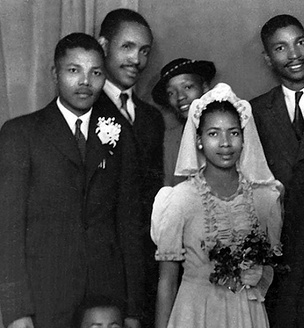
Evelyn Ntoko Mase, later named Evelyn Rakeepile, was the first wife of the South African anti-apartheid activist and the future president Nelson Mandela, to whom she was married from 1944 to 1958. Mase was a nurse by profession.
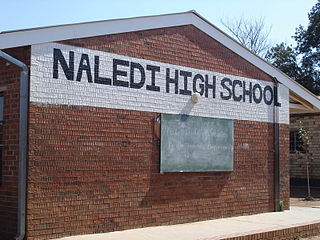
Naledi High School is a government secondary school at 892 Nape Street in Soweto. The school took an important role at the start of the Soweto Uprising in 1976.
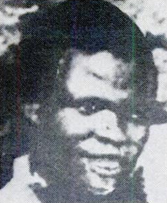
Malesela Benjamin Moloise was a South African poet and political activist who came to international attention following his arrest and subsequent execution by the government of South Africa. From Soweto, Moloise worked as an upholsterer before turning to poetry during his time on death row. In 1983, Moloise was arrested for the 1982 murder of Phillipus Selepe, a black security policeman who assisted in capturing three African National Congress (ANC) members. Although he initially confessed to the murder, he later retracted the statement during his trial. Moloise's death sentence sparked national and international outrage and was seen as emblematic of South Africa's brutal crackdown on anti-apartheid activists.

Nkululeko Habedi, professionally known as Flabba, was a South African hip-hop musician. He was a member of the South African hip-hop collective Skwatta Kamp.
Abu Baker Asvat, also known as Abu Asvat or Abu nicknamed Hurley was a South African medical doctor who practised in Soweto in the 1970s and 1980s. A founding member of Azapo, Asvat was the head of its health secretariat, and involved in initiatives aimed at improving the health of rural black South Africans during Apartheid.
The M10 is a long metropolitan route in Greater Johannesburg, South Africa. It connects Lenasia with Johannesburg Central via Soweto.
Schreiner Baduza was a South African activist who organized squatting actions in the Alexandra township in the City of Johannesburg Metropolitan Municipality. He was forcibly relocated away from Alexandra and when he returned became a church minister.


